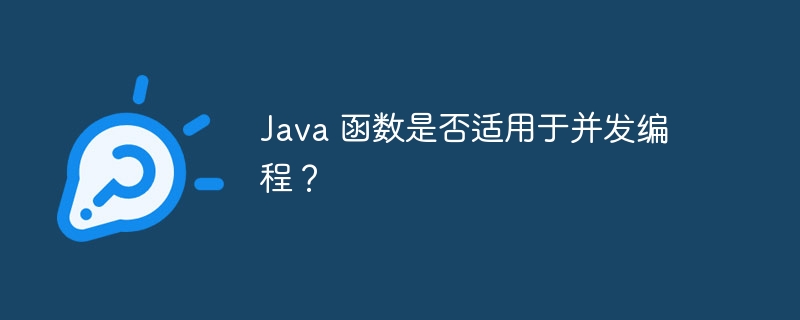Are Java functions suitable for concurrent programming?
Java functions are suitable for concurrent programming because of their simplicity, composability, and concurrency. It can be used for asynchronous programming to define tasks using short anonymous blocks of code and create complex concurrent flows by composing functions to improve application performance and responsiveness.

#Are Java functions suitable for concurrent programming?
Introduction
Java functions, also known as Lambda expressions, are a powerful tool introduced in Java 8. They provide an easy way to define anonymous functions and are widely used to simplify code and improve readability. However, when it comes to concurrent programming, are Java functions appropriate?
Challenges of Concurrent Programming
Concurrent programming involves performing multiple tasks simultaneously. This creates unique challenges, such as:
- Synchronization: ensuring tasks execute in the expected manner
- Concurrency: avoiding tasks interfering with each other
- Race conditions : Conditions that may cause errors during parallel execution
Advantages of Java functions in concurrent programming
Java functions have the following advantages in concurrent programming:
- Simplicity: Functions can be defined as short anonymous blocks of code, simplifying the writing of concurrent tasks.
- Composability: Functions can be combined to create more complex concurrent flows.
- Concurrency: The functional programming paradigm emphasizes concurrency and improves application performance by executing tasks concurrently.
Practical case: Asynchronous programming using Java functions
Sample code:
import java.util.concurrent.CompletableFuture;
import java.util.concurrent.Future;
public class AsyncExample {
public static void main(String[] args) {
// 创建一个 CompletableFuture,用于表示异步任务的结果
CompletableFuture<String> future = CompletableFuture.supplyAsync(() -> {
// 这是一个将执行异步任务的代码块
return "异步任务的结果";
});
// 注册一个回调,在任务完成后执行
future.thenAccept(result -> {
// 这里包含使用异步任务结果的代码
System.out.println("异步任务的结果:" + result);
});
// 主线程继续执行,无需等待异步任务完成
System.out.println("主线程继续执行...");
}
}Conclusion
By taking advantage of Java functions, we can simplify the writing of concurrent tasks and improve the concurrency and responsiveness of applications.
The above is the detailed content of Are Java functions suitable for concurrent programming?. For more information, please follow other related articles on the PHP Chinese website!

Hot AI Tools

Undresser.AI Undress
AI-powered app for creating realistic nude photos

AI Clothes Remover
Online AI tool for removing clothes from photos.

Undress AI Tool
Undress images for free

Clothoff.io
AI clothes remover

AI Hentai Generator
Generate AI Hentai for free.

Hot Article

Hot Tools

Notepad++7.3.1
Easy-to-use and free code editor

SublimeText3 Chinese version
Chinese version, very easy to use

Zend Studio 13.0.1
Powerful PHP integrated development environment

Dreamweaver CS6
Visual web development tools

SublimeText3 Mac version
God-level code editing software (SublimeText3)

Hot Topics
 1382
1382
 52
52
 Perfect Number in Java
Aug 30, 2024 pm 04:28 PM
Perfect Number in Java
Aug 30, 2024 pm 04:28 PM
Guide to Perfect Number in Java. Here we discuss the Definition, How to check Perfect number in Java?, examples with code implementation.
 Weka in Java
Aug 30, 2024 pm 04:28 PM
Weka in Java
Aug 30, 2024 pm 04:28 PM
Guide to Weka in Java. Here we discuss the Introduction, how to use weka java, the type of platform, and advantages with examples.
 Smith Number in Java
Aug 30, 2024 pm 04:28 PM
Smith Number in Java
Aug 30, 2024 pm 04:28 PM
Guide to Smith Number in Java. Here we discuss the Definition, How to check smith number in Java? example with code implementation.
 Java Spring Interview Questions
Aug 30, 2024 pm 04:29 PM
Java Spring Interview Questions
Aug 30, 2024 pm 04:29 PM
In this article, we have kept the most asked Java Spring Interview Questions with their detailed answers. So that you can crack the interview.
 Break or return from Java 8 stream forEach?
Feb 07, 2025 pm 12:09 PM
Break or return from Java 8 stream forEach?
Feb 07, 2025 pm 12:09 PM
Java 8 introduces the Stream API, providing a powerful and expressive way to process data collections. However, a common question when using Stream is: How to break or return from a forEach operation? Traditional loops allow for early interruption or return, but Stream's forEach method does not directly support this method. This article will explain the reasons and explore alternative methods for implementing premature termination in Stream processing systems. Further reading: Java Stream API improvements Understand Stream forEach The forEach method is a terminal operation that performs one operation on each element in the Stream. Its design intention is
 TimeStamp to Date in Java
Aug 30, 2024 pm 04:28 PM
TimeStamp to Date in Java
Aug 30, 2024 pm 04:28 PM
Guide to TimeStamp to Date in Java. Here we also discuss the introduction and how to convert timestamp to date in java along with examples.
 Java Program to Find the Volume of Capsule
Feb 07, 2025 am 11:37 AM
Java Program to Find the Volume of Capsule
Feb 07, 2025 am 11:37 AM
Capsules are three-dimensional geometric figures, composed of a cylinder and a hemisphere at both ends. The volume of the capsule can be calculated by adding the volume of the cylinder and the volume of the hemisphere at both ends. This tutorial will discuss how to calculate the volume of a given capsule in Java using different methods. Capsule volume formula The formula for capsule volume is as follows: Capsule volume = Cylindrical volume Volume Two hemisphere volume in, r: The radius of the hemisphere. h: The height of the cylinder (excluding the hemisphere). Example 1 enter Radius = 5 units Height = 10 units Output Volume = 1570.8 cubic units explain Calculate volume using formula: Volume = π × r2 × h (4
 How to Run Your First Spring Boot Application in Spring Tool Suite?
Feb 07, 2025 pm 12:11 PM
How to Run Your First Spring Boot Application in Spring Tool Suite?
Feb 07, 2025 pm 12:11 PM
Spring Boot simplifies the creation of robust, scalable, and production-ready Java applications, revolutionizing Java development. Its "convention over configuration" approach, inherent to the Spring ecosystem, minimizes manual setup, allo




